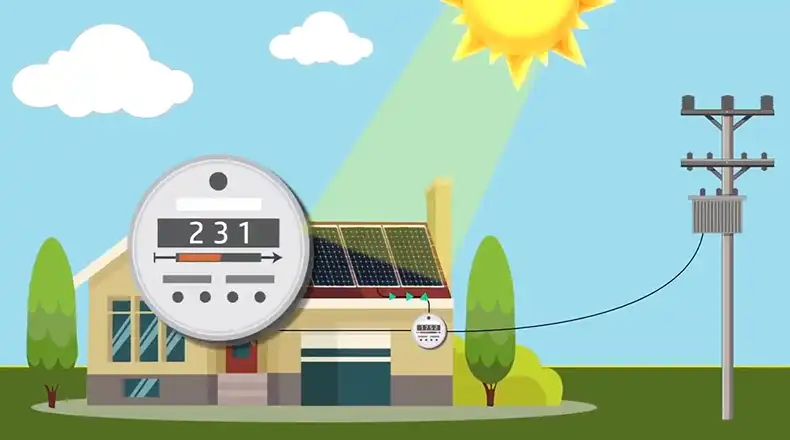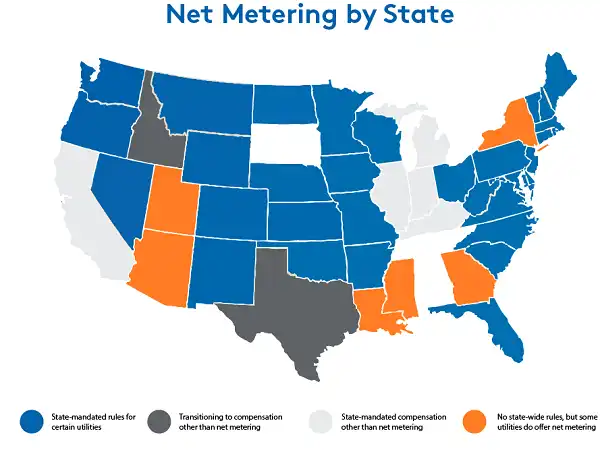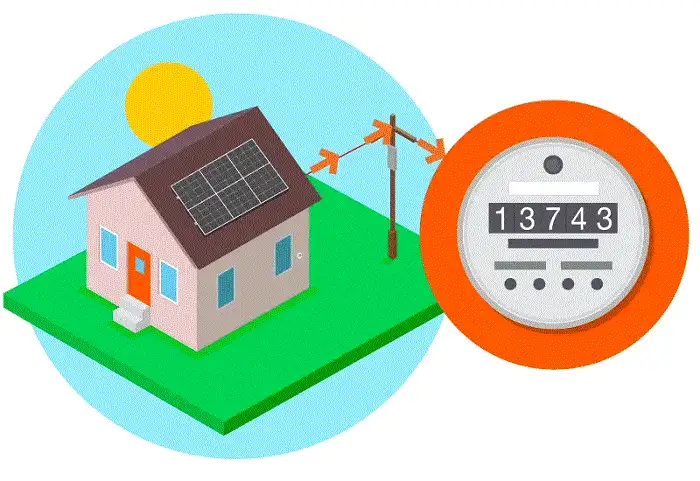How Does Net Metering Work with Solar?
Solar power offers homeowners a chance to generate their own renewable electricity. However, many wonder exactly how connecting a solar energy system to the grid works in conjunction with their utility services and billing. Confusion over “net metering” policies often deters potential solar customers.
Net metering allows solar panel owners to earn credit for excess power they generate and export to the grid. The utility company essentially runs the home’s electric meter backward when it receives more power than the home is using. This gives solar customers fair credit for their contribution while allowing them to draw from the grid when needed.
To understand the full details of how net metering policies work, we’ll explore the basics, pros and cons, how credits are tracked, impacts on utility bills, and variations in different states’ rules in this guide. Read on to learn everything homeowners should understand about coordinating solar and the grid.

How Net Metering Works
Net metering policies allow homes and businesses with solar power systems to exchange excess solar electricity for credits on their utility bills. Here is an outline of how the arrangement functions:
How Power Flows with Solar Installations
- Solar panels on roofs or ground mounts generate direct current (DC) electricity when sunlight hits them.
- An inverter converts that DC power into the alternating current (AC) electricity used by home appliances and equipment.
- When the building uses all solar power being produced, the surplus goes back to the utility grid. This export registers on the electric meter as excess generation beyond the building’s usage.
- When solar panels produce less than what the building requires, they draw supplemental power from the grid to meet its demand. This normal import registers on the meter as consumption from the grid.
How Net Metering Credits Accrue
- At any given time, the meter tracks whether the net flow of electricity is export (sending to the grid) or import (drawing from the grid).
- The utility company calculates credits, or sometimes payments, for the net excess solar electricity measured as exports to the grid.
- Over a monthly billing cycle, credits earned during solar production hours offset power drawn from the grid during other times.
- Policies determine the value of solar credits and how long they remain valid before expiring. Details vary by state and utility.
This balancing of exports and imports over time provides fair compensation for home-generated solar contributions while maintaining reliable grid access at night or when solar production is low.
Pros and Cons of Net Metering for Solar Owners
Net metering delivers significant advantages but also comes with some downsides. Evaluating the pros and cons helps solar shoppers weigh their policy options.
Benefits of Net Metering
- Saves electric bill – Electricity generated by solar panels is credited to the solar owner’s bill. But with the net metering, the energy that the solar owner exports to the grid is also credited. As a result, it saves a lot of money on the electricity bill.
- Offsets grid purchases – Solar owners earn credit for surplus power at the retail electric rate, offsetting purchases from the grid at the same value. This delivers the full value of solar production.
- Simplifies billing – Net metering eliminates the need for separate accounting, tracking, and payment for exporting solar electricity. Exports simply appear as credits reducing imports on the same utility bill.
- Enables grid independence – With enough solar power production, buildings can produce more than they use over longer time periods and achieve zero net energy consumption over a month or year.
- Avoids solar power waste – Net metering gives solar installations an outlet for excess generation, allowing systems to be right-sized for optimum production rather than limiting arrays to only match immediate on-site demand. The grid essentially acts as storage for surplus solar power.
Drawbacks of Net Metering
- Benefits decrease over time – Some policies decrease compensation rates after reaching renewable energy adoption milestones or longevity thresholds. Grandfathering rules may apply.
- Uncertainty and changes – Regulations and grid access policies for net metering vary significantly and can change over time. Grandfathering policies provide some protection.
- Grid costs and limitations – Utility companies cite extra grid infrastructure and management costs for growing renewable generation. Policies may limit volumes eligible for net metering. New charges sometimes apply.
Weighing these advantages and limitations helps solar shoppers evaluate options as part of understanding net metering’s role.
How Net Metering Credits Are Tracked and Applied
Net metering involves nuances in quantifying how much solar power flows into versus out of a building and applying the right credits or charges. Key questions include:
- How do bi-directional electric meters track imports and exports?
- When are credits earned for solar exports?
- What rate is paid for excess solar electricity?
- How do credits apply to utility bills?
- What happens if exports exceed imports over longer periods?
Here are the answers to all these questions:
Bi-Directional Electric Meters
Homes with solar power systems require a bi-directional or smart meter to separately tally imports from and exports to the grid over time. This specialized meter records consumption and production on two separate registers:
- Imports – Electricity drawn from the grid registers measured usage in kilowatt-hours (kWh), the standard billing unit.
- Exports – Surplus solar power sent out to the grid registers measured excess generation, also in kWh.
By independently tracking both imports and exports, bi-directional meters enable the application of net metering credits. Smart meters also convey real-time usage data and typically support automated meter reporting to the utility.
When Net Metering Credits Accrue
With a bi-directional meter, net metering credits accrue based on the measured net exports in each metered period. During times when solar panels produce more than a building uses internally, the surplus amount gets exported to the grid. Most policies apply credits to customer bills on a monthly billing cycle.
Each month, the utility company tabulates the household meter reading by netting exports against imports over the past month. Some programs carry over a surplus balance to future billing periods.
Rate Paid for Exported Solar Electricity
Net metering policies determine the rate paid for excess solar electricity fed onto the grid. In most states, customers earn credits at the full retail volumetric rate per kWh. This equals the normal cost paid for electricity imported from the grid.
Receiving retail rate credits delivers better solar compensation compared to lower wholesale rates paid to dedicated solar farms. However, some alternative programs pay less than the retail rate, such as through a Value of Solar Tariff.
Applying for Net Metering Credits on Utility Bills
As a solar customer’s monthly net usage gets calculated based on imports minus exports, net metering credits directly offset costs on standard utility bills. Each accrued renewable energy credit translates into an equal dollar amount deducted from the bill’s usage charges.
On a given bill, this plays out mathematically by:
- Adding up all kWh imported from the grid as consumption
- Subtracting total kWh exported to the grid as excess solar generation
- Multiplying the net kWh difference by the normal retail volumetric rate
- Applying any monthly service and fixed charges separately
As an example, a household with a $0.20/kWh rate consuming 350 kWh and exporting 200 kWh solar to the grid would calculate a $30 bill as:
- 350 kWh imported consumption
- 200 kWh exported solar
- = 150 kWh net usage
- 150 kWh x $0.20/kWh rate = $30
Without surplus solar exports, the bill would have totaled $70 for 350 kWh. So net metering credits effectively reduce costs by the $40 value of excess solar production.
Over longer periods, net metering enables zeroing out entire bills if cumulative exports match or exceed imports. Some policies extend the payback period, such as paying excess credits out annually or upon terminating grid service.
Net Exports Over Longer Periods
For homes producing more solar power than they use over weeks, months, or a year, net metering allows rolling over the net surplus balance monthly. This enables solar customers to fully offset usage over longer high-production periods, like sunny summers. Some programs provide payment or billing credits for cumulative net excess generation annually or when ending service.
However, policies typically cap the cumulative value of exports eligible for future net metering credits. For example, California’s limit resets to zero each April. Customers cannot continually stockpile credits over multiple years to eliminate bills indefinitely. Yet within policy bounds, net metering facilitates zeroing out annual usage and bills.
How Net Metering Policies Vary By State
Net metering rules differ across utility territories and states, reflecting varied renewable energy goals, solar adoption levels, and grid capacity. Policy components with significant state-by-state differences include:
System Size Limits
States set caps ranging from 10 kilowatts up to 5 megawatts on the solar array size eligible for net metering, usually on a per-meter basis. Larger systems may qualify via special exemptions or under different size-tiered pricing. These limits aim to manage grid stability and infrastructure costs with increasing distributed generation.
Bill Credit Duration
Surplus credits expire monthly in some states while accruing indefinitely in others. Some states split between shorter monthly rollover and longer annual rollover terms. Longer credit durations improve payback for solar customers.
Compensation Rate for Exports
Most states apply full retail volumetric electricity rates for net metering credits. Others use wholesale rates or special alternative solar tariffs with lower export purchase prices. Higher compensation for excess solar power improves market viability.
Annual Netting Rules
A minority of states require trueing up surplus credits only annually rather than monthly. This benefits solar customers in seasonal production environments by allowing summer overproduction to cover winter shortfalls.
Grid Access Charges
A growing number of states allow supplemental charges to fund grid infrastructure and integrate renewables. These fixed charges reduce but don’t eliminate solar savings from volumetric net metering credits.
Recognizing how specific states handle policies provides solar shoppers with a better idea of potential benefits in considering going solar. It also helps explain evolving regulatory changes.
Here are the states that have net metering in place:

Impacts of Net Metering on Utility Bills and Savings
Net metering delivers significant yet complex consumer electric bill savings. Quantifying projected savings involves utility rate structures and estimating future production and consumption.
Key Factors Impacting Bill Savings
Major elements shaping net metering savings include:
- Solar array size and site suitability optimizing generation
- Energy efficiency lowers usage and enables excess solar exports
- Retail volumetric electricity rate determining credit values
- Fixed customer charges not subject to solar offsets
- Time-of-use rate structures add complexity
- Non-volumetric surcharges related to the grid and renewables
- Ongoing utility rate inflation driving higher value of long-term solar savings
Running the numbers on these factors over the 20-30-year lifespan of solar equipment predicts long-term savings results.
Why Savings Estimates Vary
Projected savings for going solar depend heavily on assumed utility rate escalations over decades. Most analyses conservatively estimate 2-4% annual hikes. If actual increases run higher, the net metering value could exceed projections.
Similarly, technological solar performance improvements may raise exports and credit potential. However, some net metering programs phase down compensation rates upon hitting renewable energy adoption milestones.
Updating savings calculations to account for policy revisions and new rate structures also causes forecasts to shift over time. This uncertainty means realized savings may end up below or above initial estimates.

Solar Value Beyond Monthly Savings
Some analyses cite minimal utility bill reductions for net-metered solar in states with very low electricity rates. However, the value of self-generated renewable power extends well beyond monthly savings to encompass:
- Hedge against higher future rate inflation
- Lower lifetime costs via 20-30-year system lifespan
- Energy independence, reliability, and resilience
- Environmental stewardship
Evaluating solar’s value more comprehensively makes net metering’s proposition stronger in many use cases.
Conclusion
Net metering delivers a balanced approach to making adopting home solar power more viable and valuable for consumers while also upholding critical grid infrastructure. Policy variations between states and utilities determine actual program rules, compensation rates, grid fees, and other factors that shape cost-benefit outcomes for solar shoppers. But in general, net metering makes going solar both cleaner and cheaper over the long run – advancing renewable energy adoption for a more sustainable future.
Now that you understand the essential mechanisms behind net metering solar policies, you can make more informed solar purchasing decisions and calculate potential bill savings more accurately as we collectively transition toward greener, decentralized renewable electricity generation.
Your Questions, Ours Answers
Q: Can you sell excess solar power back to the grid?
A: Through net metering, excess solar generation gets sold back to the utility indirectly in exchange for energy credits on your bill. So technically you don’t sell power but your surplus offsets your normal purchases.
Q: How much do solar panels reduce your electric bill with net metering?
A: Most net-metered solar arrays reduce 20-40% or more from utility bills, but ongoing monthly savings vary significantly based on solar production, energy usage, electric rates, fees, and other factors unique to each situation.
Q: Does net metering lower the cost of a solar panel system?
A: Net metering enables a solar array to deliver full value for every unit of energy produced, significantly improving cost-effectiveness. Good net metering policies make solar payback faster and ultimately lower lifetime costs.
Q: Can you profit from net metering solar?
A: Net metering generally doesn’t produce profits, but allows offsetting grid purchases. Only a minority of states issue yearly payments for excess net exported solar electricity, rather than indefinite credit rollovers.
Q: What happens if your solar panels produce more than you use?
A: Net metering policies determine how excess solar electricity gets valued and accounted for, either rolled over month-to-month or reconciled annually at full or partial credit rates depending on your state and utility policies.






